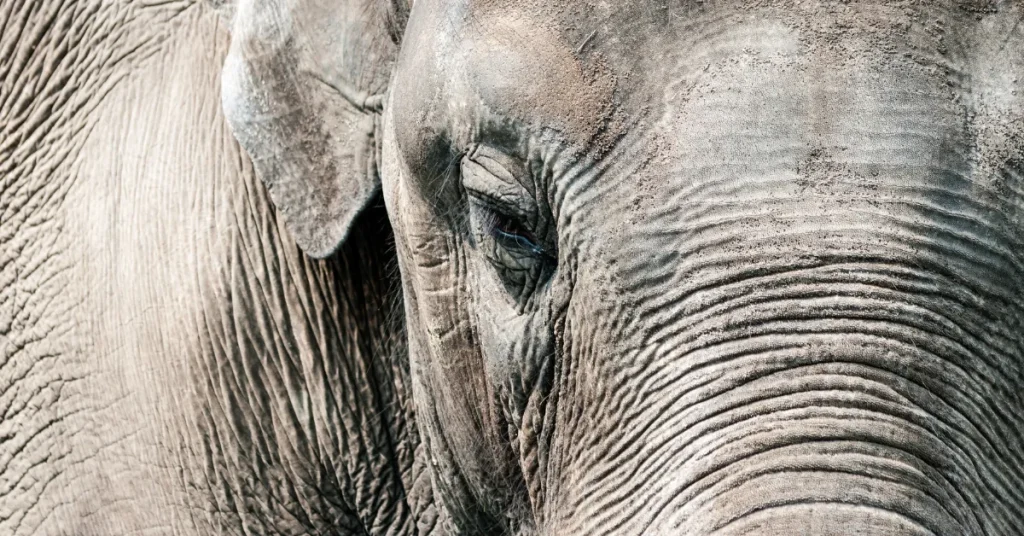Elephant skin is generally 2.5 centimeters (1 inch) thick. This robust skin serves as a protective barrier for these large mammals.
Elephants are majestic creatures that capture our imagination with their immense size and intelligence. Their skin is not only thick but also highly sensitive, despite the rough appearance.
The thickness of elephant skin varies across different parts of their body, with some areas having slightly thinner skin.
Understanding the anatomy of an elephant’s skin can offer insights into their behavior, such as their mud-bathing practices which protect their skin from sunburn and parasites.
Elephant skin care is crucial, as it reflects their health and well-being in their natural habitat or when cared for in conservation areas.
Researchers and wildlife enthusiasts often use the thickness and condition of elephant skin as an indicator of an elephant’s overall health and adaptability to their environment.

The Pachyderm’s Natural Shield
Elephant skin is a marvel in the animal kingdom. This tough hide acts as a natural shield. It keeps the giant safe from sunburn and harmful bugs. The thick skin of an elephant is something of a wonder—both strong and sensitive.
Elephant Skin Thickness
Elephants boast some of the thickest skin in the animal world. Ranging from 2.5 cm to 4 cm thick, their skin varies in different parts of their body. The skin is thinnest around their ears and mouth. On their back and sides, the skin is at its thickest, acting like a suit of armor.
Function Of The Thick Hide
- Protection: The skin shields against sun, insect bites, and injuries.
- Regulation: It helps control the elephant’s body temperature.
- Sensitivity: Despite its thickness, the skin can feel the slightest touch.
Skin Deep: Variations Across Species
Welcome to a foray into the textured world of pachyderms in ‘Skin Deep: Variations Across Species.’ Elephants, majestic and grand, possess an incredible, thick skin that is more complex than it appears.
It not only provides protection but varies intriguingly among species, ages, and sexes. Let’s uncover the fascinating aspects of elephant skin thickness!
African Vs. Asian Elephants
African and Asian elephants not only differ in size and shape but also in the thickness of their skin. African elephants, the larger of the two species, boast a thicker and more wrinkled skin. This adaptation helps them keep cool in the blazing African sun.
The skin can measure up to 30 mm thick in some parts. In contrast, the Asian elephant has comparatively thinner skin, averaging around 15 mm. They inhabit forested areas, and their skin has evolved to suit the different climate and landscape.
Age And Sex Differences In Skin Thickness
Elephants grow and change as they age, and so does their skin. Calves are born with a delicate layer that becomes thicker and tougher as they mature.
Mature males often have thicker skin than females, a trait thought to result from the battles they engage in for dominance.
This difference peaks during mating seasons when males’ skin can become especially thick around the neck and head.
The table below illustrates how age and sex influence skin thickness in elephants:
| Age | Males | Females |
| Young | Up to 10 mm | Up to 10 mm |
| Adult | Up to 40 mm | Up to 30 mm |
As elephants continue to fascinate us, their skin reveals more than just an armored exterior. It is a map of their life: where they’ve lived, the battles they’ve fought, and the parameters that govern their species.
This guide on elephant skin peels back the layers, offering a glimpse into the lives of these gentle giants.
The Biology Behind The Bulk

The Biology Behind the Bulk explores the impressive thickness of elephant skin. Elephants are majestic creatures, and their skin is just as remarkable. Let’s dive into the science that gives these animals their iconic protective layer.
Understanding Pachyderm Dermatology
Elephant skin is unique and complex. A mature elephant’s hide can be up to an inch thick. Unlike human skin, this thickness is necessary for protection and survival in the wild.
- Protection Against Elements: Thick skin shields them from the sun and keeps them safe from thorns and insects.
- Temperature Regulation: Despite its thickness, elephant skin is full of small pores that help with sweating and cooling off.
- Social Interaction: Their hide is also crucial for communicating with other elephants through touch.
Collagen And Skin Elasticity
Elasticity in elephant skin comes from an abundance of collagen. Collagen is a protein that makes skin stretchy and durable.
- Collagen Fibers: These are densely packed and woven in various directions, contributing to the skin’s resilience.
- Adaptability: Even with this thickness, their skin is capable of stretching, particularly around joints.
Adaptations For Survival
The skin of an elephant isn’t just thick for show. This majestic creature has adapted to its environment in impressive ways, turning its skin into a key survival tool.
Let’s dive into the ins and outs of elephant skin and how it contributes to their longevity in the wild.
Skin As A Thermal Regulator
Elephant skin acts as a powerful thermal regulator. Despite its thickness, which can measure up to one inch, the skin works ingeniously to keep the animal cool.
Blood vessels close to the surface release body heat into the environment. Elephants will often cover themselves in mud or water, which, as it evaporates, takes away excess heat and helps to manage their body temperature.
Protective Measures Against Parasites And Predators
The thick skin of elephants also serves as a barrier against parasites such as ticks and biting flies. Although not impervious, the skin reduces the chances of infections from parasite bites.
When it comes to predators, the sheer thickness provides protection against the teeth and claws of most would-be attackers, making adult elephants a challenging prey.
- Layers of mud – A natural insect repellent and sunshield.
- Dust baths – Used to dislodge parasites and soothe irritations.
- Wallowing – Submerging in water to prevent sunburn and regulate body temperature.
Human Impact On Elephant Dermis

The skin of an elephant tells a story of survival. It is a thick barrier that protects them. But humans have left a mark on these majestic creatures. Their skin, as tough as it is, cannot shield them from the impact of human actions.
The Toll Of Poaching
Poaching is a deadly threat to elephants. It targets their tusks but harms their skin too. Poachers often leave elephants injured.
This can lead to infections. Poachers sometimes use traps that can hurt the elephant skin. This leads to serious injuries. Each injury is a sign of a struggle for life.
- Traps and snares: Can cut into the elephant’s skin, causing wounds.
- Infections: Open wounds may get infected leading to further health issues.
- Stress: The fear of poachers adds stress to elephants, which impacts their skin health negatively.
Conservation Efforts For Skin Preservation
Conservation groups work hard to protect elephants’ skin. They fight against poaching. They protect habitats. This helps keep elephant skin healthy. Below are some ways these groups help:
- Creating protected areas where elephants can roam safely.
- Working with local communities to reduce conflicts.
- Supporting anti-poaching patrols to prevent illegal activities.
Exploring And Measuring The Mammal’s Mantle
The skin of an elephant is a marvel in the animal kingdom. It’s a shield that guards against environmental factors. Its thickness varies across different parts of the body.
To understand these gentle giants, one must delve into the depths of their skin. Let’s dive into the ways scientists measure this extraordinary feature.
Methods Of Assessing Skin Thickness
Measuring the thickness of an elephant’s skin requires precision. Researchers have developed several methods for this task:
- Direct measurement: In this approach, skin thickness is measured using calipers. This is done during medical examinations or post-mortem studies.
- Ultrasound: Vets use ultrasound technology to gauge the skin’s depth. This method is non-invasive and safe for the animals.
- Biopsy samples: In specific studies, small, safe, skin samples provide a microscopic view of skin structure.
Technological Advances In Pachyderm Research
Technology has transformed elephant dermatology studies. Important advancements include:
| Technology | Function | Impact on Research |
| 3D imaging | Creates a three-dimensional model of the skin | Offers detailed skin topography without harm |
| Infrared thermography | Measures skin temperature patterns | Helps understand skin health and blood flow |
| Digital calipers | Provides precise skin thickness readings | Gives accurate measurements for small areas |
These advancements provide insights into the thickness, health, and function of elephant skin. They help conserve and care for these magnificent mammals. Up-to-date methods ensure their well-being and guide conservation efforts.
FAQs about How Thick Is Elephant Skin
How Thick Is Elephant Skin In Inches?
An elephant’s skin is typically about 1 inch thick, providing them with protection and temperature regulation.
Is Elephant Skin Like Human Skin?
Elephant skin differs significantly from human skin. It’s much thicker, up to 1 inch, and has a rougher texture, providing greater protection. Despite these differences, both types still serve the fundamental function of safeguarding the body.
Do Elephants Have Thin Skin?
Elephants do not have thin skin; it is quite thick, up to one inch in some areas, to provide protection and regulate body temperature.
How Does Elephant Skin Feel?
Elephant skin is rough and wrinkled, yet surprisingly sensitive to touch. It is thick and can appear quite dry.
Conclusion
Elephant skin thickness astonishes many, averaging at about 1 inch (2. 54 cm). This remarkable adaptation shields them from heat and predators.
Understanding this aspect of elephant biology enriches our perspective on these majestic creatures. So, whether observing them in the wild or studying their characteristics, elephant skin remains a topic of wonder and admiration.
Resources:
1. https://www.smithsonianmag.com/smart-news/How-African-Elephants-Get-Their-Wrinkles-180970463/
